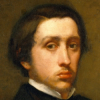Edgar Degas

Edgar Degas
Edgar Degaswas a French artist famous for his paintings, sculptures, prints, and drawings. He is especially identified with the subject of dance; more than half of his works depict dancers. He is regarded as one of the founders of Impressionism, although he rejected the term, preferring to be called a realist. He was a superb draftsman, and particularly masterly in depicting movement, as can be seen in his renditions of dancers, racecourse subjects and female nudes. His portraits are notable...
ProfessionPainter
Date of Birth19 July 1834
CityParis, France
It's easy to have talent at 20 but what is difficult is to have talent at 50.
For those who don't know what they are doing, painting is easy. For those who do know what they are doing, painting is difficult.
If painting weren't so difficult, it wouldn't be fun.
One reproduces only that which is striking; that is to say, the necessary. Thus, one's recollections and inventions are liberated from the tyranny which nature exerts.
I always urged my contemporaries to look for interest and inspiration to the development and study of drawing, but they would not listen. They thought the road to salvation lay by the way of colour.
I have been, or seemed, hard with everyone because I was carried away by a sort of brutality born of my distrust in myself and my ill-humor. I have felt so badly equipped, so soft, in spite of the fact that my attitude towards art seemed to me so just. I was disgusted with everyone, and especially myself.
I put it (a still life of a pear, made by Manet, ed.) there (on the wall, next to Ingres' Jupiter, ed.), for a pear like that would overthrow any god.
People call me the painter of dancing girls. It has never occurred to them that my chief interest in dancers lies in rendering movement and painting pretty clothes.
Hitherto the nude has always been represented in poses which presuppose an audience. But my women are simple, honest creatures who are concerned with nothing beyond their physical occupations... it is as if you were looking through a keyhole.
Once they witnessed one of his painting sold at auction for $100,000. And asked how you do it, he said, 'I feel as a horse must feel when the beautiful cup is given to the jockey.'
A picture is first of all a product of the imagination of the artist; it must never be a copy.
People call me the painter of dancers, but I really wish to capture movement itself.
The artist does not draw what he sees, but what he has to make others see.
The frame is the reward of the artist.